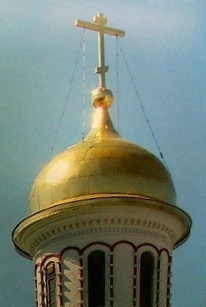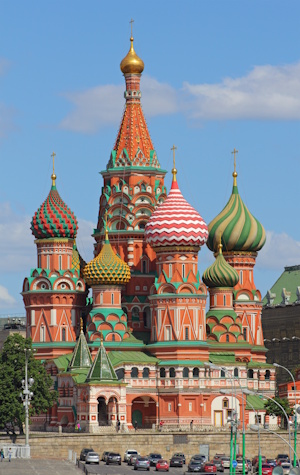Eastern Orthodox Cross
also known as the Ukrainian, Byzantine, Greek Orthodox, Macedonian, Slavic or Slavonic Cross
The Eastern Orthodox Cross is seen in various shapes and forms, and typically has three cross beams and is distinctly different from other Christian crosses.
Orthodox and Byzantine Catholics, Ukrainian Orthodox and Russian Orthodox Christians, all have much in common. Sadly, however, some things they violently disagree on, evidenced by the Russian Patriarch Kirill's support for the cruel and deadly invasion of neighbouring Ukraine, giving Putin religious justification for his territorial ambitions, which are obviously so contrary to Christian values.
This page, however, focuses on the historical symbolism of the Eastern Orthodox cross.
The deep meanings and traditions of icons were preserved from Byzantium through the Christian Empire it established in Eastern European countries. (See also the Bezant Cross and St. Nicholas Cross). Byzantium, the capital of the Byzantine Christian Empire, was later renamed Constantinople and is now known as Istanbul. The region’s culture is a rich blend of various iconographic traditions.
Alexander Roman tells us that in the East, and Russia in particular, a cross with three bars was worn by the lowest rank of priest; a privilege granted by the Russian Emperor Paul I (1754-1801). Higher ranking clergy wore one-bar crosses, such as Metropolitans and Abbots. In the West, the reverse was true - additional bars signified higher clerical or other significance. Two-bar crosses in the West signified important Christian centres, i.e., patriarchal centres. Only the pope had a three-bar Cross. (See also Papal Cross)
The top beam, also seen on the Patriarchal cross, represents the plaque bearing Pontius Pilate's inscription "Jesus the Nazorean, King of the Jews" (see INRI). The Latin for such a plaque is titulus which gives the name for this form: Titulus Cross. The upper beam rarely has any inscription; it's just symbolic of a titulus. However, this cross is often embellished with the acronym IC XC NIKA. (See also ICXC Cross)
The lower beam represents a foot-support (suppedaneum) and began appearing in Eastern Christian art in the 6th century. The purpose of the suppedaneum was to support the weight of the body, thereby keeping the crucified person alive longer to prolong the agony. We don't know whether such a device existed on Jesus' cross. (See Suppedaneum Cross)

The suppedaneum on crosses found in the Greek Orthodox Churches and Ukrainian Catholic Churches are often horizontal, in contrast to the diagonal suppedaneum other Eastern crosses.

A popular interpretation for the slanted suppedaneum is to symbolize a balance-scale showing the good thief St. Dismas, having accepted Christ, would ascend to heaven, while the thief who mocked Jesus would descend to hell. With this, the Cross is a balance-scale of justice. A similar lower beam is also found on another form of Patriarchal Cross where there is only one upper beam.
When first encountering this cross with a slanting lower beam, one can be forgiven for thinking it's a Three-Dimensional Cross. Its similarity with a key is a convenient reminder that the cross is not only the key to forgiveness but also the key to life.
Another explanation of the slant reflects half of the X-shaped Saltire cross of St. Andrew, who was the first Christian missionary to Russia.
The story goes that when Andrew preached in southern Russia, he used a large three-bar cross as a visual teaching aid. All three bars were parallel, and when explaining the Passion he tilted the lower footrest to signify that those on the right side of Christ will rise up into heaven and those on the left will slide down into hell. (See also Keys to heaven and Right-hand side of God.)

St. Basil's Cross (left) has perhaps been the most photographed Eastern crosses. It's on one of the onion domes of the Cathedral of the Intercession of the Most Holy Theotokos on the Moat, or St. Basil's Cathedral for short, after the local saint, Basil the Blessed, whose tomb is located inside.

Before Putin destroyed Russia's image of being a desirable place for tourists, you could have admired the centuries-old architecture of this tiny cathedral in Moscow's Red Square. It overlooks the annual military parades, displaying the country's military hardware, including tanks, missiles, and troops, to remind the world of Russia's military strength.
One has to wonder what St. Basil would think of it all.
When I visited the cathedral in the mid-1980s, I was so struck by its Disney-like appearance that I never really noticed the crosses on the top; as though they were just an afterthought.
See also the Church of Greece emblem


